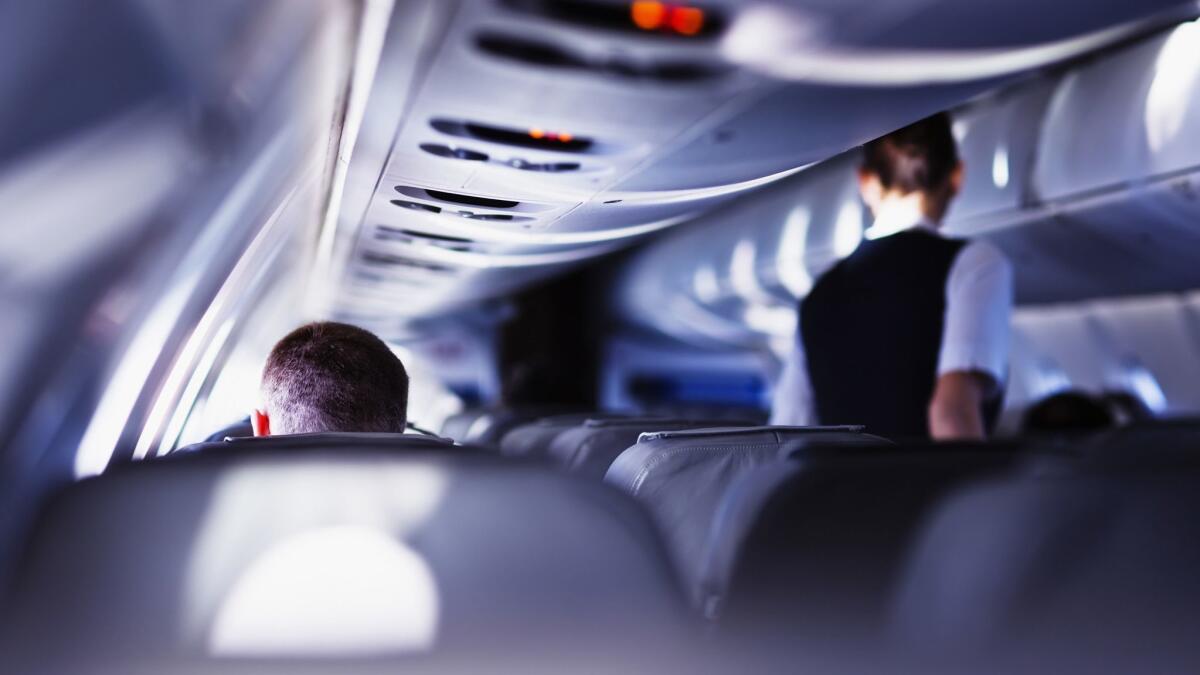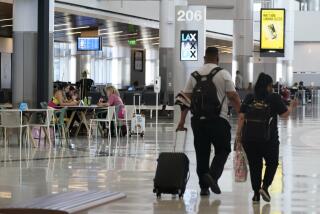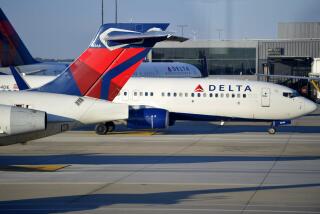Some issues with cabin crew are valid, but toilet paper that unfurls wrong? C’mon

- Share via
It’s not unusual for passengers to lodge complaints against flight attendants and the airlines we work for. Many issues are legitimate. Others? Not so much. In fact, some complaints are so outrageous they leave my fellow flight attendants and me scratching our heads in disbelief.
For instance, on a routine flight from Los Angeles to Miami, a first-class passenger summoned me using her flight attendant call button. When I arrived at her seat, the woman asked, “Can you watch my baby while I use the lavatory?”
I politely said, “No, ma’am.”
“What?” she said. “Why not?”
The “baby” in question was a Yorkshire terrier that had been registered as an emotional support animal. Before boarding, passengers traveling with an emotional support animal, or ESA, submit a signed document confirming that they will be 100% responsible for the animal during flight.
I reminded the woman of the airline’s ESA policy.
“But I need to use the lavatory,” she said.
ESAs are allowed to sit on the owner’s lap or on the floor at the owner’s feet. They’re allowed to walk up and down the aisle with the owner. They’re even allowed to accompany owners to the lavatory.
When I explained this to her, the response was swift. She asked for my name and promised to file a complaint. My offense? Refusing to dog-sit on a commercial flight.
On a different flight, a passenger emerged from the lavatory and stepped into the aft galley where I was loading the beverage cart.
“I have a complaint,” she said. The woman seemed visibly upset. I thought maybe the passenger before her had left a mess in the lavatory. Perhaps the toilet was stopped up.
Instead, the woman jabbed a finger at me and said, “Your airline needs to make a policy so that toilet paper rolls out from the top instead of the bottom.”
A toilet paper policy?
I stared at her a moment, stunned that someone could be so unhappy about the direction in which toilet paper is dispensed on an airplane. Maintaining my composure, I provided her with information so she could file her official complaint.
Once, while I served beverages in the main cabin, a passenger asked for “a half cup of coffee.” As requested, I poured what appeared to me to be a half a cup of coffee and handed it to the man. He handed it back, claiming there was too much coffee in the cup. I apologized, grabbed a new cup and poured a tad less coffee than in my previous pour.
When I offered it to the passenger, he said it wasn’t enough. “I want half a cup,” he said. “Half.”
Resisting the urge to abandon professional standards, I told him that neither of us had a measuring cup. I then filled the coffee cup to perhaps two-thirds, handed it to him and invited him to drink as much or as little as he liked. He responded by threatening to lodge a complaint against me.
One of my flight attendant colleagues, a Brazilian American woman in her 30s, told me about an incident that involved her on a recent flight. She had been serving food and drinks to an older couple when the wife suddenly went ballistic.
The wife claimed my colleague purposely and repeatedly brushed her breasts against the husband’s arm.
My co-worker explained that she had been reaching across the husband to place items on his tray table. In the process, she may have inadvertently brushed against the elderly man’s arm. But the wife refused to accept that explanation.
Convinced that a young, attractive female flight attendant had made a brazen attempt to entice her elderly husband, the wife pulled out a cellular phone and proceeded to take photos of my co-worker. (Would this prove the flight attendant was pretty and, therefore, a more worthy threat?) The wife then loudly proclaimed that an official complaint would be forthcoming.
My colleague is still waiting to hear from her supervisor about this.
U.S. airlines do take complaints seriously. For passengers flying on the four largest carriers — American, Delta, Southwest and United — the filing process is easy. They simply log on to the airline’s website, scroll to “Contacts” or “Need Help?” and follow the links.
When passengers lodge complaints through these official channels, a supervisor will contact the flight attendant to discuss the matter. This happened to me when a passenger claimed I removed his meal tray “without his knowledge or approval” and in doing so, had carelessly thrown away the $800 clear orthodontic retainer sitting beside his half-eaten chicken piccata.
He demanded a full reimbursement from the airline.
My supervisor called and read the complaint letter verbatim. He asked to hear my side of the story.
I explained that after dinner, I had asked this passenger (as I do with all passengers) to hand me his unwanted meal tray. This tells me they are finished with the tray and everything on it, including half-eaten food, miscellaneous trash, etc.
The complaining passenger handed me his tray; of this I am certain. Perhaps the see-through retainer was hidden among the trash. I don’t know. But saying I removed his meal tray “without his knowledge or approval” was not true.
I don’t know whether the airline reimbursed him, but I was acquitted of any wrongdoing.
Serious grievances require face-to-face meetings that can result in a warning, suspension or, if the situation merits, termination of employment.
If a customer accused a flight attendant of inappropriate touching, as was the case with the aforementioned female flight attendant, she would show up to the meeting with a union representative. Witness statements, if available, are taken into account as is the flight attendant’s previous record. Her job may hang in the balance until guilt or innocent can be determined.
As is the case with corrupt police officers, unscrupulous lawyers and dishonest politicians, blameworthy flight attendants should be treated accordingly.
But a complaint about not babysitting your dog? Please.
More to Read
Sign up for The Wild
We’ll help you find the best places to hike, bike and run, as well as the perfect silent spots for meditation and yoga.
You may occasionally receive promotional content from the Los Angeles Times.






